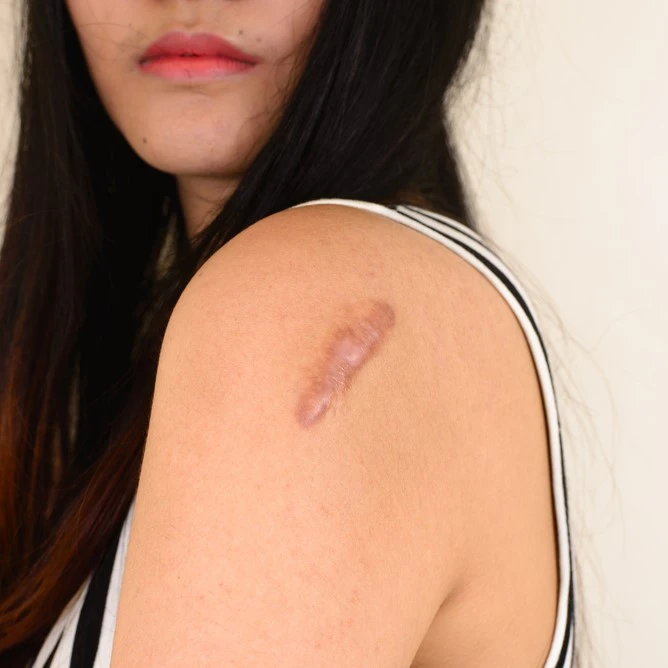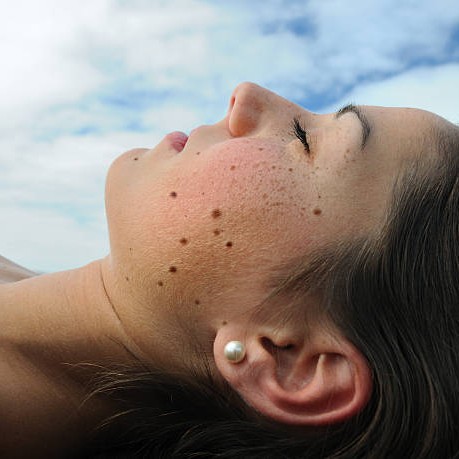Smooth skin, tag-free: Trust us for expert Skin Tag Removal
Read in Arabic ( علاج إزالة علامات الجلد )
Are you tired of feeling self-conscious about those unsightly skin tags? Skin tags are a common and harmless skin condition, but they can be a nuisance and affect your confidence. Fortunately, there are safe and effective options for removing them. With our expert skin tag removal services, you can say goodbye to those pesky skin tags and hello to smooth, healthy skin. Our experienced team will provide you with the best possible care, ensuring a quick and easy removal process. Read on to learn more about how our skin tag removal services can help you feel confident and comfortable in your own skin.
Procedure Time
15 Mins
Downtime
5 - 10 Days
Back to Work
Immediate
Results
2 - 3 Weeks
What is Skin Tag Removal?
Skin tags are small, usually harmless growths of skin that can appear in various parts of the body, such as the neck, armpits, eyelids, and groin area. They can be annoying or unsightly, but they generally don’t pose any health risks.
If you have a skin tag that you want to remove, there are several options available. Some people choose to remove skin tags at home using over-the-counter products or natural remedies, while others prefer to have them removed by a healthcare professional.
If you decide to remove a skin tag at home, be sure to follow the instructions carefully and use a product that is specifically designed for skin tag removal. Don’t try to cut off the skin tag with scissors or any other sharp object, as this can be dangerous and can cause infection.
If you decide to have a healthcare professional remove your skin tag, they may use one of several methods, such as cutting it off with scissors, freezing it with liquid nitrogen, or burning it off with an electrical current. The method they choose will depend on the location and size of the skin tag, as well as your individual needs and preferences.
Overall, skin tag removal is a safe and straightforward procedure, but it’s important to choose the right method for you and to follow all instructions carefully to ensure the best results. If you have any concerns or questions, be sure to talk to your healthcare provider.
Skin Tag Removal Before and After
Here you can clearly see the before and after difference of skin tag removal.If you want to know more, get yourself a free consultation now at Enfield Royal Saudia.




Who needs Skin Tag Removal?
Skin tag removal is usually a matter of personal preference rather than medical necessity. Skin tags are usually harmless and do not require removal for health reasons. However, some people may choose to have their skin tags removed for cosmetic reasons or if the skin tag is in a location that causes irritation or discomfort, such as under the bra line or in the groin area. Additionally, skin tags that are unusually large, bleed, or change in appearance may require medical attention and removal by a healthcare professional. Ultimately, the decision to have a skin tag removed is up to the individual and should be based on their personal preferences and concerns.
What causes Skin Tags?
Here are some simple bullet points explaining what causes skin tags:
Skin tags are usually caused by friction or rubbing against the skin.
They can develop in areas where skin rubs against skin, such as the neck, armpits, groin, and under the breasts.
Obesity or pregnancy can increase the likelihood of developing skin tags due to increased skin folds and friction.
Genetics may also play a role in skin tag development.
Certain medical conditions such as diabetes, hormonal imbalances, and human papillomavirus (HPV) may increase the risk of developing skin tags.
Age is another factor that can contribute to the development of skin tags, as they are more common in middle-aged and older adults.
What are the benefits of Skin Tag Removal?
Here are some points explaining the benefits of skin tag removal:
- Removal of skin tags can improve appearance and boost self-confidence.
- If skin tags are in an area that rubs against clothing or other skin, their removal can prevent irritation, discomfort, and potential infection.
- Removing skin tags can improve personal hygiene, as they can trap dirt and sweat, leading to unpleasant odors and bacterial growth.
- If a skin tag is bleeding, growing rapidly, or changing in appearance, removal can be necessary to rule out any underlying medical conditions and prevent complications.
- In some cases, a healthcare professional may recommend removing a skin tag if it is causing discomfort or if it is located in an area that may cause complications during certain medical procedures, such as surgery or radiation therapy.
Procedure of Skin Tag Removal
There are several methods that can be used to remove skin tags, depending on the size, location, and type of skin tag. Here are some common methods:
Cutting
A healthcare professional can use a scalpel or surgical scissors to remove the skin tag. The area may be numbed with a local anesthetic first.
Freezing
This method is also known as cryotherapy. A healthcare professional can use liquid nitrogen to freeze the skin tag, which will cause it to fall off within a few days.
Burning
This method is also known as cauterization. A healthcare professional can use a special tool to burn the skin tag off.
Ligation
This method involves tying a small band around the base of the skin tag to cut off its blood supply. After a few days, the skin tag will fall off.
The skin tag removal procedure is usually quick and simple, and can be performed in a healthcare provider’s office or clinic. Depending on the method used, local anesthesia may be applied to the area before the procedure to minimize pain or discomfort. After the skin tag is removed, a small wound may be left behind, which will typically heal on its own within a few days to a week. It is important to follow any aftercare instructions provided by the healthcare professional to prevent infection and promote healing.
Aftercare of Skin Tag Removal
After the skin tag removal procedure, it is important to take good care of the area to promote healing and prevent infection. Here are some general aftercare instructions:
Keep the area clean and dry: Avoid getting the area wet for at least 24 hours after the procedure to allow the wound to heal. After that, gently wash the area with soap and water and pat it dry with a clean towel.
Avoid picking or scratching the area: This can cause infection and slow down the healing process. Let the wound heal naturally.
Apply an antibiotic ointment: A healthcare professional may recommend applying an antibiotic ointment to the wound to prevent infection and promote healing.
Avoid strenuous activity: Avoid activities that may cause sweating or rubbing against the wound, such as exercise or wearing tight clothing, for a few days after the procedure.
Follow up with your healthcare professional: If you experience any pain, bleeding, or signs of infection such as redness, swelling, or pus, contact your healthcare professional right away.
Risks of Skin Tag Removal
While skin tag removal is generally considered safe, there are some potential risks and complications to be aware of. Here are some common risks associated with skin tag removal:
Infection: Anytime the skin is punctured or cut, there is a risk of infection. It is important to keep the area clean and follow any aftercare instructions provided by your healthcare professional to minimize the risk of infection.
Bleeding: Skin tag removal may cause bleeding, especially if the skin tag is large or if you are taking blood-thinning medications. Your healthcare professional can apply pressure to the wound or use a topical agent to stop the bleeding.
Scarring: Depending on the location and size of the skin tag, there may be a risk of scarring after removal. This risk can be minimized by following aftercare instructions and avoiding picking or scratching the wound.
Pain or discomfort: You may experience some pain or discomfort following the skin tag removal procedure. Your healthcare professional may recommend taking over-the-counter pain medication or applying a cold compress to the area to alleviate discomfort.
Numbness or tingling: In rare cases, skin tag removal may cause numbness or tingling in the surrounding area. This is usually temporary and will resolve on its own.
While these risks are generally low, it is important to discuss them with your healthcare professional and weigh the benefits and risks of skin tag removal before proceeding with the procedure.
Steps to minimize the risks
Here are some points on how to minimize the risks of skin tag removal:
- Choose a qualified healthcare professional to perform the procedure.
- Follow any pre-procedure instructions provided by the healthcare professional.
- Discuss any medications or health conditions with the healthcare professional before the procedure.
- Follow any aftercare instructions provided by the healthcare professional, such as keeping the area clean and dry and applying antibiotic ointment.
- Avoid picking or scratching the wound to minimize the risk of infection and scarring.
- Avoid strenuous activity and tight clothing for a few days after the procedure to reduce the risk of bleeding or irritation.
- Monitor the area for any signs of infection, such as redness, swelling, or pus, and contact the healthcare professional if any complications arise.
What is the recovery time of Skin Tags Removal?
The recovery time for skin tag removal can vary depending on the size and location of the skin tag and the type of removal procedure performed. In general, however, the recovery time is relatively short and most people are able to resume normal activities within a few days.
Immediately after the procedure, you may experience some mild pain, swelling, or redness in the treated area. This should subside within a few days. In some cases, a scab or crust may form over the wound, which will usually fall off within a week or two.
It is important to follow any aftercare instructions provided by your healthcare professional to promote healing and prevent complications. This may include keeping the area clean and dry, avoiding strenuous activity, and applying antibiotic ointment.
If you experience any signs of infection, such as increased pain, redness, or discharge from the wound, contact your healthcare professional right away. They can provide additional guidance on how to care for the area and ensure proper healing.
Cost of Skin Tags Removal in Riyadh
The cost of skin tag removal can vary depending on several factors, such as the location of the treatment center, the size and number of skin tags being removed, and the type of procedure used.
In Riyadh the cost of skin tag removal can range from 10,000- 22,000 SAR minimum and 18,000 – 40,000 SAR standard per session, depending on the factors mentioned above. Insurance typically does not cover the cost of cosmetic procedures such as skin tag removal.
It is important to consult with a qualified healthcare professional or skin specialist to discuss the cost and options for skin tag removal. They can provide a personalized quote based on your individual needs and circumstances.
Skin Tag Removal
Starting FromSkin Tag Removal
StandardWhy Choose Us?
If you’re looking for a reliable and professional healthcare provider to perform skin tag removal, here are some reasons why you should choose us:
Our healthcare professionals are experienced and knowledgeable doctors in skin tag removal procedures. They use the latest techniques and equipment to ensure safe and effective removal of skin tags.
If you’re looking for a trusted healthcare provider for skin tag removal, we would be honored to serve you. Please book an appointment with us at Enfield Royal clinic Riyadh today to learn more about our services and how we can help you achieve your skin health goals.
FAQs.
It is not recommended to attempt to remove skin tags at home, as this can increase the risk of infection and scarring. It is important to seek professional medical advice from a qualified healthcare professional or dermatologist.
While skin tag removal is typically effective, there is a chance that new skin tags may develop over time, especially if you are prone to developing skin tags. However, regular skin exams and proper skin care can help prevent new skin tags from forming.
Relevant Treatments.

Skin Lesion Removal
A skin lesion is an additional region of skin. It is the patch of skin that is distinct from the rest of the body. It consists primarily of warts, skin tags, moles, and birthmarks. It is true that lesions diminish with time, however, this is not always the...

Mole Removal
Are you tired of feeling self-conscious about your moles? Do you have a suspicious-looking mole that’s been causing you worry? If so, mole removal may be the solution you’ve been looking for. Mole removal is a safe and effective medical procedure that can remove...





